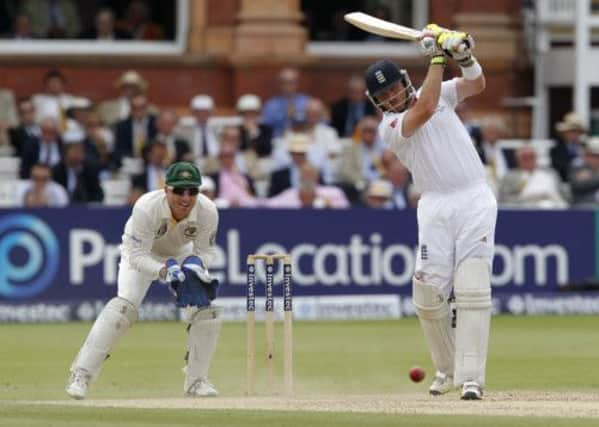Allan Massie: Don’t write off Aussies


The rash selection of shots and careless execution have made it easy for England. There was a brief recovery when Peter Siddle got Alastair Cook, Trott and Kevin Pietersen out cheaply in the second innings, only for Joe Root, Tim Bresnan and Bell again to take the match away. In short Australia were as feeble as any Aussie side I can remember.
Still, talk of England winning the series 5-0 is foolish, tempting Fate too. Matches and series can turn round quickly. It’s hard to believe that the Australian top order can continue to bat as badly. Their first six batsmen have now had 18 innings and made only three fifties. That’s a miserable record. One or two have been unlucky. More have been careless. Shane Watson must infuriate any coach because of his apparent inability to play a long innings, and his tendency to get out in the same way again and again and again.
Advertisement
Hide AdAdvertisement
Hide AdSome blame too much 50-over and T20 cricket for the impatience of these batsmen. They may be right, but Chris Rogers, Usman Khawuja and Philip Hughes all have experience of county cricket here. Rogers has hit more first-class centuries – 60 – than any current English batsman. Hughes, still aged only 24, has hit 21 centuries, more than England’s youngsters, Root and Bairstow, together. These Australian batsmen are neither mugs nor novices, but they don’t seem mentally attuned to Test match cricket.
Michael Clarke is a great batsman with a Test record better than Cook or Pietersen. But he too is struggling. Admittedly Anderson bowled him with a beauty at Trent Bridge, and Broad had him lbw with a splendid in-swinging yorker in the first innings at Lord’s. Second time round there, however, he should have been stumped by Matt Prior when he was beaten coming down the pitch to Swann immediately he came in, and his eventual dismissal – caught Cook at leg-slip off Root – was daft, Cook having just moved himself to that position; thank you very much.
Clarke’s captaincy has been widely admired. I’m not so sure. First, I think that as by far the best batsman in his struggling side, he should take the responsibility of coming in at three, as Bradman and Ponting did. Second, in the field, his preference for giving his pace bowlers very short spells denies them the chance to develop a plan against a particular batsman. Then his decision not to take the new ball when it became available on Saturday evening smacked of surrender. It was as if he was saying to Cook, “I don’t care how long you bat”.
Still, all isn’t lost for Australia. Their pace attack is good and has had England in trouble in every innings. James Anderson may be the most skilful bowler on either side, but Ryan Harris and Peter Siddle are every bit as effective as Stuart Broad and Tim Bresnan, perhaps better. Mitchell Starc had Cook in all sorts of difficulties at Trent Bridge, where James Pattinson also bowled well.
The gamble of playing young Ashton Agar rather than the off-spinner Nathan Lyon hasn’t paid off – at present the boy looks a better batsman than bowler. He was stupidly run out by his vice-captain, Brad Haddin, in the first innings at Lord’s and got a rotten decision in the second one.
The first difference between the two sides is that in each innings England have found at least a couple of batsmen willing to apply themselves, knuckle down, leave the ball outside the off-stump, and wait for the bad one, or until the bowlers tire and scoring becomes easier. As Adam Gilchrist said recently: “It’s between the ears – a batsman’s skill levels don’t improve between Tests.” Ian Bell has been magnificent, showing the mental application the Australians have lacked. He has reminded me of Ken Barrington, the most successful English batsman of those who began their careers after the 1939-45 war – no higher praise is possible. Joe Root’s second innings at Lord’s was exemplary, a model of how to play Test cricket: self-denying and watchful in defence for a long time, then unleashing a flurry of brilliant strokes after he passed 50.
Alastair Cook and Kevin Pietersen have each made one half-century, otherwise been out cheaply three times. This is worrying for England, because they can’t rely on Bell to pull them out of the soup every match, especially since Jonathan Trott has been strangely skittish. Of course it’s a bit worrying for Australia too. If they can’t get in a winning position when Cook and Pietersen are failing, what sort of a mess will they be in when either starts to come good or indeed when Trott plays with the sort of application we’re accustomed to? And Matt Prior hasn’t made any runs yet either, though he has a Test average of 43.
In short, but for Bell and Root at Lord’s, and to some extent Bairstow, the English batting hasn’t been any better than the Australians’.
Advertisement
Hide AdAdvertisement
Hide AdSo the outcome of the next Test (from which Pietersen may be missing) may depend on which of England’s or Australia’s underperforming batsmen come good. Meanwhile to be two up is better for the confidence than being two down.
The second difference between the sides has been Graeme Swann, England’s best off-spinner since Jim Laker. He has now taken more wickets than Laker, thanks in part to Hawk-Eye’s role in improving umpires’ understanding of LBW, even the Law concerning which was, one may add, very different in Laker’s day.